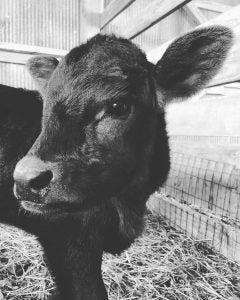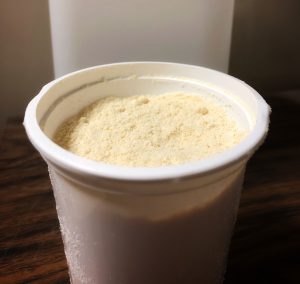If you’ve ever raised cattle, it’s likely that you’re familiar with colostrum and what it is. But, do you realize how crucial it is to newborn calf health?
If you’re a producer or someone who, at some point in time, has ever been faced with the challenge of raising orphaned newborn calves on your own, chances are you do. Maybe the cow became paralyzed during parturition (birth) and the calf never got the opportunity to nurse. Perhaps the calf was a twin — the twin the cow refused to claim. Maybe complications during the birthing process rendered the calf weak, which made standing and first attempts at nursing too difficult. The list of possible scenarios could go on and on, many of which I am familiar with. I’ve dealt with some of these instances in my own beef cattle, some of which resulted in me raising newborn calves on a bottle, starting with colostrum.
Of utmost importance to the growth, development, and health of any newborn calf is the need to keep sickness and death (often caused by pathogens) at bay. A significant portion of this need is satisfied shortly after a “normal” birth (one free of any major complications in which the cow and calf are presumably healthy and attentive of one another), when the calf nurses colostrum — the first form of milk produced — from the cow. It’s a process called “transfer of passive immunity,” in which essential proteins (antibodies or immunoglobulins), among other nutrients (such as fats, vitamins, and minerals), are “passed” from the dam (mother of the calf) to the calf in order to protect it from disease.
Without colostrum, the newborn calf essentially has no immunity, since calves are born with what we commonly refer to as “naive” immune systems — immune systems that are functional, but not fully developed. Think of a newborn calf’s immune system as a somewhat empty toolbox. The calf is born with the toolbox (immune system), but isn’t born with all the tools that go in it, which are necessary for protection against disease caused by bacteria and viruses, among other things. Therefore, colostrum intake is critical.

It’s also important to understand that antibodies do not cross a cow’s placenta during pregnancy, hence a reason why calves are born with underdeveloped immune systems. So, in order to increase a calf’s likelihood of survival and to promote health, growth, and protection against disease, intake of colostrum from the dam within the first six hours or less (ideally within the first two to four hours) after birth is crucial. Why within these first few hours? Because the small intestine of the calf is best able to absorb antibodies within the first few hours after birth. It’s physiological. Anytime colostrum is ingested after those first few hours, the efficiency of antibody absorption declines (significantly after 12 hours), and generally little to no absorption occurs as far out as 24 hours after birth.
In a perfect world, every calf receives colostrum from its dam, and intake is in a timely manner. Unfortunately, we don’t live in a perfect world and things don’t always work out as expected. So, what happens when there is no colostrum intake soon after birth, or colostrum is of poor quality, and you must intervene? Depending on the circumstances (every situation is unique in itself) and time frame, you may have to resort to using an alternative source of colostrum.
If you’re experienced in these types of situations, you’ve planned ahead, the opportunity presented itself, or you’re a dairyman, chances are you collected and either refrigerated or froze colostrum from another dam in your herd ahead of time. This isn’t always possible in a beef herd because of the nature of, well, a beef herd. In a beef herd, there’s generally a lot less human involvement, or “intervention,” so to speak, when compared to that of a dairy herd. It’s just not common practice for those of us with beef cattle to take the calf away from the dam and bottle-feed it (unless it’s necessary) or have multiple dams available at once to collect colostrum from. Nevertheless, regardless of what your preferred alternative method of obtaining colostrum may be, it’s important to keep in mind that refrigerated colostrum is only good for a short period of time before it decreases in quality and/or sours, and it’s imperative that you make sure the refrigerator is cold enough (33-35°F) to inhibit the growth of bacteria. If you properly froze colostrum anytime within the past year or so, generally, and the freezer was maintained at an ideal temperature (typically -5°F), it‘s usually OK to use, as long as it is thawed properly to prevent antibody degradation.

Also common is the use of powdered colostrum replacer that can be purchased at many local feed stores. I try to keep a few packets of powdered colostrum replacer on-hand (well within the date of expiration) during calving season for potential and unexpected emergency situations. It’s convenient and readily available, the directions for preparation are clearly printed on the package, and it can be prepared quickly. You’re also able to avoid having to deal with some of the time and temperature sensitivity factors of thawing frozen colostrum in order to prevent protein degradation by using powdered colostrum replacer.
In the grand scheme of things, you’ll have to figure out which method works best for you and your herd (if you don’t already have a preference), but it’s important to have a plan when emergency situations crop up. Whether a calf receives colostrum naturally from its dam or by way of a colostrum replacement method, it’s imperative that we understand the importance of that first nursing as a critical component of calf health that sets the stage for life after birth.
Callie Burnett is a farm girl, animal scientist, and biologist whose heritage is deeply rooted in agriculture. She is an alumna of Clemson University with a Master of Science in Animal & Veterinary Sciences.



